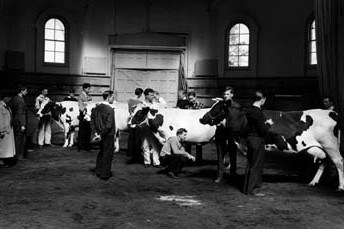
Cattle judging class in the 1930s
The Department of Dairy and Animal Science and its predecessors have always had the education of students as one of its' highest priorities. The original departments of Dairy Husbandry and Animal Husbandry were basically organized as teaching departments.
The first dairy major was Dairy Husbandry, initiated in 1905, which incorporated dairy production and dairy manufacturing. In 1907, the major of Animal Husbandry was initiated to provide teaching of courses in producing beef cattle, horses, sheep, swine, and poultry. The major also had consisted of work in the meats area. In 1940 the Department of Dairy Husbandry offered two majors: Dairy Production and Dairy Manufacturing. In 1960, the two majors became Dairy Production and Dairy Technology. Also in 1960, the Department of Animal Husbandry and the Department of Animal Nutrition merged, and the new Department of Animal Science and Industry offered a major in Animal Industry.
In 1966, the College of Agriculture formed a Division of Animal Science and Industry consisting of the departments of Animal Science, Dairy Science, Veterinary Science, Poultry Science, and Entomology. This division, designated to coordinate and plan undergraduate curriculums, established two majors: Animal Industry and Animal Science. The Animal Science major administered by Poultry Science, Dairy and Animal Science and Veterinary Science was renamed Animal Bioscience in 1978. In 1976, the divisional approach was disbanded, and the current Department of Dairy and Animal Science was formed by the merger of Animal Science and Dairy Science, which offered majors in Animal Production and Dairy Production. In 1989 these two majors were combined into Dairy and Animal Science. This major was in place until 1999 at which time the Departments of Dairy and Animal Science and Poultry Science collaborated to create the interdepartmental major Animal Sciences.
Graduate programs developed early in the history of the various departments. The first report of these programs was in 1908, when four graduate students were enrolled. Graduate training and graduate students have continually played an important role in these various departments with graduate students making significant contributions to research and teaching.
Undergraduate Clubs
The departments involved with the dairy and animal sciences at Penn State have always supported undergraduate clubs. Two clubs that have been active over the years are the Dairy Science Club and the Block and Bridle Club. These clubs encourage student socialization and fellowship, provide academic and professional experience, and provide the opportunity to develop leadership skills. The largest events of the two clubs are the Little International Livestock Exposition and the Dairy Exposition, initiated in 1917 and 1922, respectively. The shows provide students with the opportunity to work cooperatively with other students and develop leadership skills, as well as obtaining experience working directly with animals of the various species. These events are organized, run, and financed by the students and their clubs. In 2002, the 76th Dairy Exposition and the 85th Little International were held.
Judging Teams
Judging teams have continually been valued and sponsored by the Department of Dairy and Animal Science and its predecessors. The judging teams and courses serve a variety of educational purposes, perhaps the most important being the experience the students obtain in organizing their thoughts and information and presenting them in an organized, clear, and comprehensive manner. The students develop their communication ability through oral and written presentations. The ability to accumulate and evaluate information and form judgments based on this information is an asset. The students also learn much valuable technical knowledge about livestock, their physical traits, and their function. Over the years students have participated on judging teams in Livestock, Dairy Cattle, Dairy Products, Horses, Wool, Meats, and Meat Animal Evaluation.
After Graduation
Although post-graduate performance is difficult to quantify, graduates have in general found jobs available in their fields of interest upon graduation. The major field of opportunity has been in the industries associated with animal agriculture and agriculture in general, with the feed industry being one of the major employers. Many of the graduates enter fields of education and public service with jobs in teaching, extension, research, and government service. A sizable number go into production agriculture. The following lists of Distinguished Alumni indicate the wide range of occupations the department's graduates have undertaken.
Author: G. W. Sherritt, Professor of Animal Science

